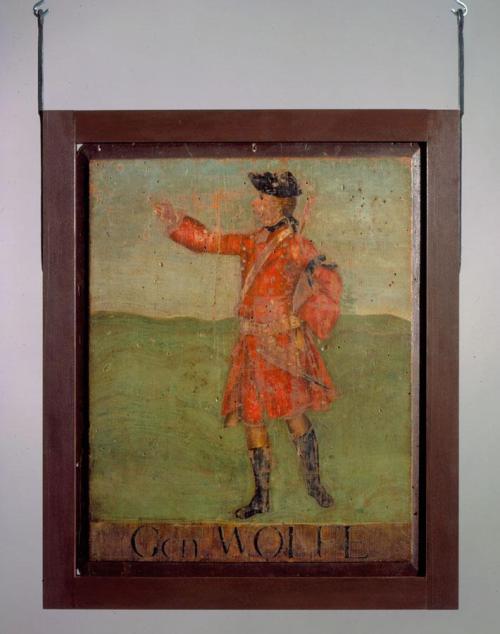Sign of General Wolfe
Original OwnerOriginally owned by
General Israel Putnam
(American, 1718 - 1790)
PainterPainted by
Unknown
Dateabout 1768
MediumPaint on pine board
DimensionsOther (height x width of sign only): 30 x 24 1/4in. (76.2 x 61.6cm)
Other (overall, including hardware, height x width ): 40 1/4 × 28 1/4in. (102.2 × 71.8cm)
ClassificationsPainting
Credit LineGift of Rufus S. Mathewson
Object number1841.11.0
DescriptionImages on both sides: full-length profile portrait of General James Wolfe, in red military uniform, with right hand upraised and index finger pointing forward, centered on board; green background below horizon line; no underlying images.
Construction: Single board, raised and fielded on both sides, one side with a wider bevel.
Surface: This sign displays only one paint layer on each side; side two is more weathered. Several details of the uniform and sword-belt are raised above the surface plane, with opinions differing on whether this effect is the result of partial relief carving or of preferential weathering, which wore away the thinly painted white areas more quickly than more heavily coated, colored areas. Mylar tracings reveal that the two portrait figures are identical, pointing to the use of a template. Letters are partially raised or recessed and may have been carved; they appear to have been applied free-hand. The background, applied after the figure was painted, displays broad, undulating brush-strokes.
Construction: Single board, raised and fielded on both sides, one side with a wider bevel.
Surface: This sign displays only one paint layer on each side; side two is more weathered. Several details of the uniform and sword-belt are raised above the surface plane, with opinions differing on whether this effect is the result of partial relief carving or of preferential weathering, which wore away the thinly painted white areas more quickly than more heavily coated, colored areas. Mylar tracings reveal that the two portrait figures are identical, pointing to the use of a template. Letters are partially raised or recessed and may have been carved; they appear to have been applied free-hand. The background, applied after the figure was painted, displays broad, undulating brush-strokes.
Collections
Label TextThe inn that this sign represented was owned by Patriot General Israel Putnam, who served under British General James Wolfe during the French and Indian War. Wolfe, who is featured on this sign, was killed leading an Anglo-American force at the Battle of Quebec, well before the Revolutionary War, and so he was seen as a hero by Americans even during the Revolution. Nevertheless, the sign contains buckshot holes, which, according to oral history, were caused by angry Patriots firing at the sign during the Revolution.
NotesHistorical Note, original location: Putnam's tavern is sometimes confused with his farmhouse, which he occupied from 1739 until after his remarriage in 1767 to Deborah Lathrop Avery Gardiner. The Putnam farm lay in the northwestern section of Brooklyn, near the Pomfret town line, on what is now Route 93-five miles distant from the main road. The General Wolfe was situated much more conveniently, on the green in Brooklyn, in a house inherited by the second Mrs. Putnam from her first husband, the Reverend Ephraim Avery, Brooklyn's first ordained minister. The road through Brooklyn carried travelers bound from Boston and Worcester, Massachusetts, to Norwich and New London, Connecticut. Although neither Putnam's farmhouse nor the tavern house remain standing, their locations are marked by stone tablets. A three-story house, built about 1778 by Putnam's daughter Mehitable and her husband, General Daniel Tyler, was later the site of another well-known tavern, Mortlake House or Manor; it can be seen in many views of the Putnam monument on the Brooklyn green. The village of Brooklyn was part of the town of Pomfret in Putnam's time, from which it was incorporated in 1786.Status
On view










